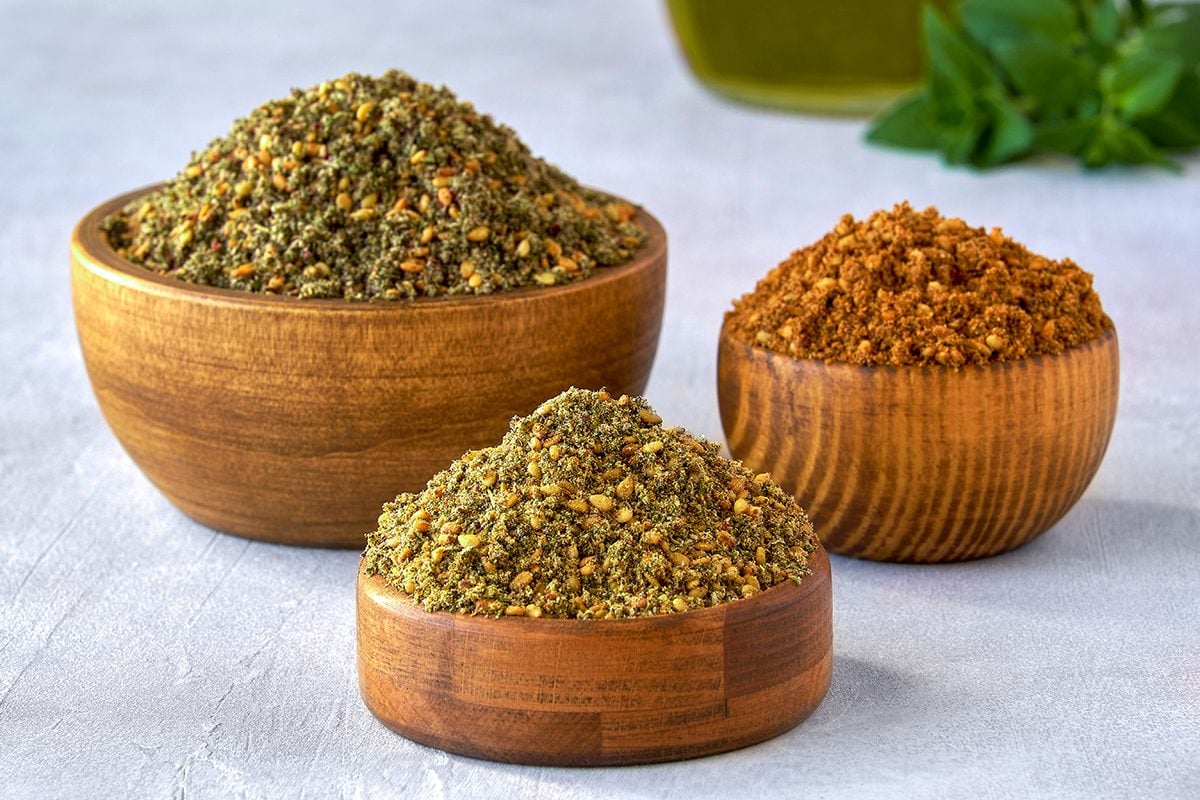If you’ve stumbled over the word “za’atar” in an ingredient list, there’s no need to feel embarrassed—but there’s also no need to continue missing out on this amazing Middle Eastern spice blend.
Hard on the heels of the trend for Mediterranean recipes comes a growing interest in Middle Eastern cuisine—and at the heart of Middle Eastern food is a delectable, fragrant blend of spices called za’atar.
What is Za’atar?
Yes, it can be a little confusing. Za’atar has some of the same naming issues as curry—while there is a curry plant, the name usually refers to a blend of spices. The za’atar herb is an aromatic variety of wild oregano (that’s also known as hyssop and Syrian marjoram). But usually, za’atar refers to a spice blend. The ingredients (and proportions of ingredients) can vary from region to region—even household to household, as individual cooks create their own signature flavor. Most za’atar blends contain sesame seeds, dried thyme or oregano, marjoram, salt and sumac. (Wild cards include paprika and cumin.)
With each of those fragrant ingredients contributing its own distinctive notes, za’atar has a full and complex flavor. Sumac brings bright citrus taste, oregano’s slight bitterness balances the sweetness of marjoram, and sesame provides an earthy, slightly nutty base.
What is Za’atar Used For?
Za’atar is used in practically everything in Middle Eastern cuisine; it’s a table spice as well as a cooking spice. If you’ve never tasted za’atar before, get to know its flavor by mixing it with olive oil and using it as a dip for fresh bread. Remember when it seemed like every Italian restaurant in the country started setting out small plates of olive oil sprinkled with Italian seasonings as a dipping sauce for fresh, warm focaccia? Za’atar serves the same role with warm pita bread. Or, use just enough olive oil to create a paste, and smear it over pita dough before baking (you can use pizza dough, too!). Even simpler—smear prebaked pitas with za’atar paste and bake that way. That same mixture, either as a paste or of drizzling consistency—can be served over plain Greek yogurt or hummus or used as a marinade.
On its own, za’atar makes a great dry rub for meats and grilled or roasted vegetables like cauliflower, potatoes and eggplant. It’s an excellent complement to dairy; rolling a log of goat cheese in za’atar and pairing it with pita chips or crackers makes an easy and distinctive appetizer. You can even stir this spice blend into your favorite dip (homemade hummus comes to mind) and serve.
Where Can I Get It?
A few years ago, za’atar would have been difficult to find outside of Middle Eastern groceries. Now, it can be found more and more at gourmet groceries and specialty spice shops. As with curry, Ras El Hanout and Chinese Five Spice, increasing popularity equals increasing commercial availability. Can’t find za’atar in your local shops? You can order it online, of course, at the spice supplier of your choosing. (There are some good options here, here and here.) Again, every blend is a little bit different, so you may want to try a few to choose your favorite.
When buying za’atar, check the ingredient list and make sure it contains sumac; many suppliers keep costs down by using citric acid to approximate sumac’s bright, lemony notes—but it’s not the same!
If you’re making a recipe that calls for Za’atar (like our scrumptious za’atar chicken recipe) and don’t want to wait for an online order, you can use thyme, tahini paste, sesame seeds, or straight sumac instead. They won’t give you the more complex flavor of za’atar, but they’ll do in a pinch and will give you a similar Middle Eastern flair.
How to Make Your Own
If you find you love za’atar, do what all those cooks throughout the Middle East do, and make your own—you can experiment with the proportions to get your perfect blend. A good starting point is two tablespoons each of oregano, sumac and sesame seeds, and a tablespoon each of marjoram, thyme and fine sea salt. Toast the sesame seeds before adding them for more flavor. You can toast them whole or use a mortar and pestle to break them up a bit.
The name might have made you stumble, but you’ll quickly find za’atar is one of the most versatile seasonings out there. As a starting point, try using za’atar with any of these Mediterranean recipes. Then sprinkle it in salads, into pastas, over rice and grains, meats and vegetables… there’s really no wrong use!
The post What is Za’atar and How to Use It in Your Cooking appeared first on Taste of Home.
Hazel Wheaton

